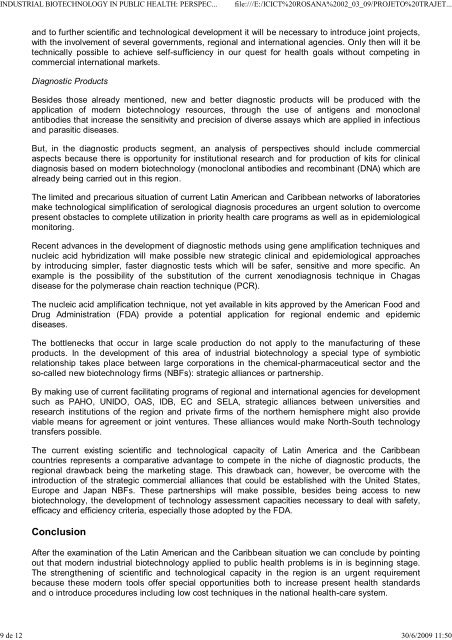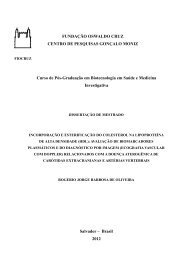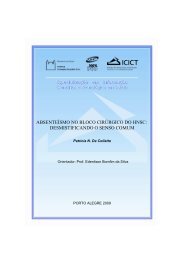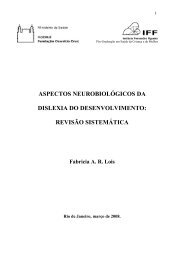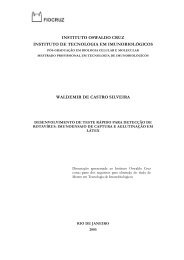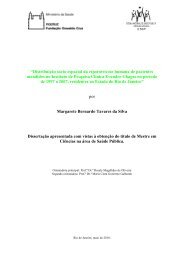industrial biotechnology in public health - Arca - Fiocruz
industrial biotechnology in public health - Arca - Fiocruz
industrial biotechnology in public health - Arca - Fiocruz
Create successful ePaper yourself
Turn your PDF publications into a flip-book with our unique Google optimized e-Paper software.
INDUSTRIAL BIOTECHNOLOGY IN PUBLIC HEALTH: PERSPEC... file:///E:/ICICT%20ROSANA%2002_03_09/PROJETO%20TRAJET...<br />
and to further scientific and technological development it will be necessary to <strong>in</strong>troduce jo<strong>in</strong>t projects,<br />
with the <strong>in</strong>volvement of several governments, regional and <strong>in</strong>ternational agencies. Only then will it be<br />
technically possible to achieve self-sufficiency <strong>in</strong> our quest for <strong>health</strong> goals without compet<strong>in</strong>g <strong>in</strong><br />
commercial <strong>in</strong>ternational markets.<br />
Diagnostic Products<br />
Besides those already mentioned, new and better diagnostic products will be produced with the<br />
application of modern <strong>biotechnology</strong> resources, through the use of antigens and monoclonal<br />
antibodies that <strong>in</strong>crease the sensitivity and precision of diverse assays which are applied <strong>in</strong> <strong>in</strong>fectious<br />
and parasitic diseases.<br />
But, <strong>in</strong> the diagnostic products segment, an analysis of perspectives should <strong>in</strong>clude commercial<br />
aspects because there is opportunity for <strong>in</strong>stitutional research and for production of kits for cl<strong>in</strong>ical<br />
diagnosis based on modern <strong>biotechnology</strong> (monoclonal antibodies and recomb<strong>in</strong>ant (DNA) which are<br />
already be<strong>in</strong>g carried out <strong>in</strong> this region.<br />
The limited and precarious situation of current Lat<strong>in</strong> American and Caribbean networks of laboratories<br />
make technological simplification of serological diagnosis procedures an urgent solution to overcome<br />
present obstacles to complete utilization <strong>in</strong> priority <strong>health</strong> care programs as well as <strong>in</strong> epidemiological<br />
monitor<strong>in</strong>g.<br />
Recent advances <strong>in</strong> the development of diagnostic methods us<strong>in</strong>g gene amplification techniques and<br />
nucleic acid hybridization will make possible new strategic cl<strong>in</strong>ical and epidemiological approaches<br />
by <strong>in</strong>troduc<strong>in</strong>g simpler, faster diagnostic tests which will be safer, sensitive and more specific. An<br />
example is the possibility of the substitution of the current xenodiagnosis technique <strong>in</strong> Chagas<br />
disease for the polymerase cha<strong>in</strong> reaction technique (PCR).<br />
The nucleic acid amplification technique, not yet available <strong>in</strong> kits approved by the American Food and<br />
Drug Adm<strong>in</strong>istration (FDA) provide a potential application for regional endemic and epidemic<br />
diseases.<br />
The bottlenecks that occur <strong>in</strong> large scale production do not apply to the manufactur<strong>in</strong>g of these<br />
products. In the development of this area of <strong><strong>in</strong>dustrial</strong> <strong>biotechnology</strong> a special type of symbiotic<br />
relationship takes place between large corporations <strong>in</strong> the chemical-pharmaceutical sector and the<br />
so-called new <strong>biotechnology</strong> firms (NBFs): strategic alliances or partnership.<br />
By mak<strong>in</strong>g use of current facilitat<strong>in</strong>g programs of regional and <strong>in</strong>ternational agencies for development<br />
such as PAHO, UNIDO, OAS, IDB, EC and SELA, strategic alliances between universities and<br />
research <strong>in</strong>stitutions of the region and private firms of the northern hemisphere might also provide<br />
viable means for agreement or jo<strong>in</strong>t ventures. These alliances would make North-South technology<br />
transfers possible.<br />
The current exist<strong>in</strong>g scientific and technological capacity of Lat<strong>in</strong> America and the Caribbean<br />
countries represents a comparative advantage to compete <strong>in</strong> the niche of diagnostic products, the<br />
regional drawback be<strong>in</strong>g the market<strong>in</strong>g stage. This drawback can, however, be overcome with the<br />
<strong>in</strong>troduction of the strategic commercial alliances that could be established with the United States,<br />
Europe and Japan NBFs. These partnerships will make possible, besides be<strong>in</strong>g access to new<br />
<strong>biotechnology</strong>, the development of technology assessment capacities necessary to deal with safety,<br />
efficacy and efficiency criteria, especially those adopted by the FDA.<br />
Conclusion<br />
After the exam<strong>in</strong>ation of the Lat<strong>in</strong> American and the Caribbean situation we can conclude by po<strong>in</strong>t<strong>in</strong>g<br />
out that modern <strong><strong>in</strong>dustrial</strong> <strong>biotechnology</strong> applied to <strong>public</strong> <strong>health</strong> problems is <strong>in</strong> is beg<strong>in</strong>n<strong>in</strong>g stage.<br />
The strengthen<strong>in</strong>g of scientific and technological capacity <strong>in</strong> the region is an urgent requirement<br />
because these modern tools offer special opportunities both to <strong>in</strong>crease present <strong>health</strong> standards<br />
and o <strong>in</strong>troduce procedures <strong>in</strong>clud<strong>in</strong>g low cost techniques <strong>in</strong> the national <strong>health</strong>-care system.<br />
9 de 12 30/6/2009 11:50


